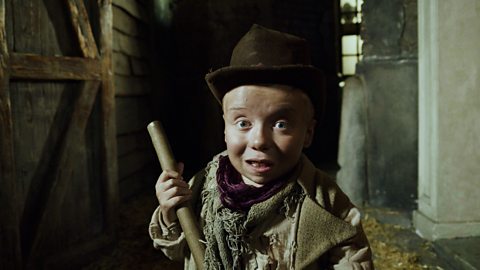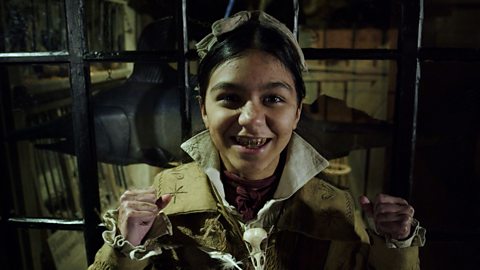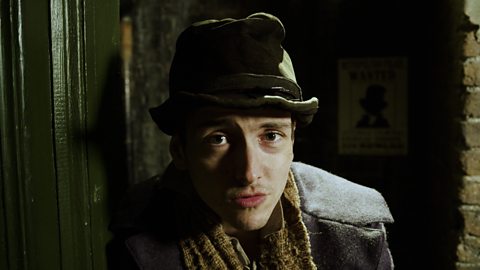DODGER:
Oi, it ain’t all urchins and slums. We Victorian Britons are quite a clever bunch, ain’t we?
POLLY:
Yeah, we invented the telephone.
TOM:
The bicycle.
CHARLEY:
Stamps, the penny black and the two pence blue.
TOM:
And jelly babies.
MORGAN:
That is some achievement, especially the jelly babies, I love the jelly babies.
TOM:
Let's start with the telephone. It was invented by Alexander Graham Bell, who was originally from Scotland, although he later became a US citizen.
POLLY:
The first words spoken down a telephone line were, “Mr Watson, come here, I want to see you.”
DODGER:
They could have thought of something better to say than that!
CHARLEY:
Then there was photography. Everyone in Victorian Britain went mad for it.
TOM:
And if you wanted your photo taken, you had to be really still like this.
TANG:
William Henry Fox Talbot was one of the first people in Britain to take photographs.
POLLY:
He took this photo of a broom, probably because it could sit really still.
DODGER:
That is the most boring photo I've ever seen.
MORGAN:
Queen Victoria was the first monarch in the whole wide world to be photographed.
DODGER:
Though a photo of her hubby, Prince Albert, came before it.
CHARLEY:
More inventions! In 1856, an engineer named Henry Bessemer invented a new method of turning iron into steel.
DODGER:
It meant we could build ships, bridges and great big walloping things on a scale like never before.
MORGAN:
And then there came the trains.
TOM:
Before trains the fastest way to travel was on horses.
DODGER:
Trains changed everything.
POLLY:
Between 1830 and 1890, transport in Britain was turned on it’s head with a massive railway network.
TOM:
With loads of railway track laid down, it meant that people could travel faster and further than ever before.
POLLY:
All of Britain's big cities like London, Glasgow and Manchester were now connected.
CHARLEY:
There were 8000 miles of railway.
MORGAN:
All of a sudden people from different areas could mix.
CHARLEY:
People from the north.
TANG:
Met people from the south.
POLLY:
You could move to a whole new area to work.
DODGER:
You could take holidays and day trips to the beach. Oh, lovely.
TOM:
Even the newspapers could travel.
POLLY:
New political ideas spread.
TOM:
Railways provided lots of jobs, like building the trains.
MORGAN:
Running the trains.
TANG:
And the upkeep too.
CHARLEY:
British time became standardised because trains had to run to a set timetable.
POLLY:
What, so before that, people just made up the time did they?
TANG:
It's midnight.
CHARLEY:
No, it's not. It's three o'clock in the afternoon.
TANG:
Midnight!
CHARLEY:
Three o'clock!
TANG:
Midnight!
CHARLEY:
Three o'clock!
POLLY:
Neither of you are right, it’s lunchtime.
DODGER:
Talking of lunch, ports could put all their fresh seafood on a train to the market.
MORGAN:
So that meant more people could eat fish.
POLLY:
And carrots and other veg.
TOM:
And milk and cheese.
MORGAN:
They could all reach the market whilst fresh, no one likes a glass of sour milk.
CHARLEY:
And this was thanks to a very clever engineer called…
DODGER:
Isambard
TANG:
Kingdom
POLLY:
Brunel.
TOM:
He built railways.
MORGAN:
And designed bridges.
TANG:
And tunnels.
DODGER:
Viaducts. What’s a viaduct?
TOM:
And passenger ships.
MORGAN:
In 1858, Brunel built the Great Eastern steamship.
DODGER:
It was 211 meters long and weighed 19,000 tons. That is a walloping great ship.
POLLY:
Well, yeah, it was the world's biggest ship to date. It only took 15 days to get from Liverpool to New York City.
TOM:
The London Underground.
CHARLEY:
Better known to most people as the tube…
TOM:
Got its start in Victorian times too, with its first line in 1863.
POLLY:
Today, I mean, your present day, millions of people use trains in the UK every day.
TANG:
All aboard!
MORGAN:
Oh, hang on a minute. If all the horses get replaced by trains then whose muck am I going to sweep? And they call that progress.
Video summary
In this short film for primary schools Dodger and the gang provide a guide to those inventions from the Victorian era which changed lives then and now.
They talk about the invention of the telephone, the bicycle and how an engineer named Henry Bessemer invented a new method of turning iron into steel. This led to the construction of bridges and ships on a scale never seen before.
Key figures such as Isambard Kingdom Brunel and Alexander Graham Bell are also introduced.
The short film is from the BBC Teach series Dodger's Guide to Victorian Britain.
Teacher Notes
Before watching the film
This film covers a wide range of inventions and so the focus for follow up work may relate to topics being studied in science or DT. In terms of history, the most significant invention of the period was the railway. Although the steam locomotive was invented before Victoria became queen, it was during her reign that much of the railway network in Britain was built.
Questions to consider whilst watching the film
Depending on the focus of your lesson, you may wish to ask the following questions after the video or pause the short film at certain points to check for understanding.
- Are there any inventions which are still important today? Are there any which are no longer as important?
- Who invented the telephone?
- What were the effects of Henry Bessemer's invention?
- How did the railways change life in Britain?
- Why was the engineer Isambard Kingdom Brunel famous?
- At the end of the video, the crossing sweeper complains that the new trains will put him out of work. Which other groups might be worried that these inventions would have a bad effect on their lives?
- All of the inventors mentioned in the film were men. Why do you think that might be?
After watching the film - activities to further explore learning
Concept of consequence - One of the most important concepts in history is cause and consequence. Causation will be a focus for the video on Victorian London. For this video, there is an opportunity to explore consequence by focusing on the effects of the railways on society.
Dodger and his gang do make reference to some of the main ways in which railways impacted on society, like the growth of cities and suburbs and seaside holidays. There are many others as can be seen in this resource. Although it is designed for older secondary students and some of the language may need to be adapted, most of the ideas in the table can be understood by upper primary children.
There are several ways this type of resource can be used but the most common is through a card sort where groups of students are provided with the different effects of the railways on separate cards. How the cards are then to be sorted is up to the teacher. One approach is temporal; the children can sort the cards between short term changes (those that only really changed the lives of people in Victorian times or just after) and long term changes (those still affect our lives today). Another valid categorisation is the one adopted on the webpage. KS2 pupils do not need to use the terms social, political or economic but if you wish to use that form of classification then the words people, power and money can be used.
Concept of significance - There is also an opportunity for the pupils to make judgements about the significance of the inventors mentioned. The class could be divided into groups and each one has to research one inventor; this could include those mentioned in the video: Alexander Graham Bell, William Henry Fox Talbot, Henry Bessemer or Isambard Kingdom Brunel. In addition, other inventors from the period could also be included: for example, Louis Braille, George Washington Carver, Thomas Edison, Louis Pasteur, Wilhelm Rontgen or Nikola Tesla. This could also be an opportunity to explore more diverse figures, so female inventors like Sarah Guppy, Ellen Eglin or Margaret Knight. With their research, each group needs to convince the class that their inventor is the most significant.
An enjoyable, yet rigorous, approach to this is through a balloon debate, which develops the pupils speaking and listening skills. Another way of doing this may be to adopt a Dragon’s Den format with the groups having to 'pitch’ their inventions for class approval.When exploring significance, it is important for the class to have some agreed criteria upon which to make their decision; for example, this can be the based on time (which has had the longest lasting impact) or society (which has impacted on the lives of most people). This needs to be the criteria for judging the balloon debate or Dragon’s Den lesson, rather than making decisions just on the children’s speaking and presenting skills. These criteria could be adopted in a third approach to historical significance, which is the creation of 'Top Trump' cards for each inventor.
England
From the History national curriculumPupils should:
- understand historical concepts such as cause and consequence… and significance.
- understand the methods of historical enquiry, including how evidence is used rigorously to make historical claims.
Northern Ireland
From the statutory requirements for Key Stage 2: The World Around UsPupils should be enabled to explore:
- Change over time in places.
To provide a balance of experiences in history pupils could study:
- Technological change and the impact of inventors and inventions over time.
- Reasons for and effects of historical events._
Pupils should be enabled to explore:
- ways in which change occurs over both short and long periods of time in the physical and natural world.
Teaching should provide opportunities for children as they move through Key Stages 1 and 2 to progress:
- from sequencing events and objects on a time line in chronological order to developing a sense of change over time and how the past has affected the present.
Scotland
From the Experiences and Outcomes for planning learning, teaching and assessment of Second Level Social Studies
- I can use primary and secondary sources selectively to research events in the past.
- I can investigate a Scottish historical theme to discover how past events or the actions of individuals or groups have shaped Scottish society.
- I can discuss why people and events from a particular time in the past were important, placing them within a historical sequence.
Wales
From the new Humanities Area of Learning and ExperienceSchool curriculum design for History should:
- develop rich content across the time periods, through which learners can develop an understanding of chronology through exploring … cause and effect … and historical significance.
- expose learners of all ages to a range of historical periods on a local, national and global scale.
Principles of progressionDescriptions of learning for Progression Step 2
Enquiry, exploration and investigation inspire curiosity about the world, its past, present and future:
- I can collect and record information and data from given sources. I can then sort and group my findings using different criteria.
Events and human experiences are complex, and are perceived, interpreted and represented in different ways:
- I can recognise and explain that my opinions and the opinions of others have value.
Human societies are complex and diverse, and shaped by human actions and beliefs:
- I have explored some causes and effects of events and changes in my community over time.
Dodger's guide to being a Victorian kid. video
In this short film for primary schools Dodger and the gang provide a brief guide to life for children in Victorian Britain, including some of the ways in which children were employed.

Dodger's guide to poverty and the workhouse. video
In this short film for primary schools Dodger and the gang provide a brief guide to the Victorian workhouse and the common diseases from the time, particularly cholera.

Dodger's guide to Victorian London. video
In this short film for primary schools Dodger and the gang provide an introduction to Victorian London which was, at that time, the biggest city in the world.

Dodger's guide to crime and punishment. video
In this short film for primary schools Dodger and the gang provide a brief guide to crime and punishment in Victorian Britain.
